УДК 539.2 ASSYMETRIС BEHAVIOUR OF AMPLIFIED
advertisement
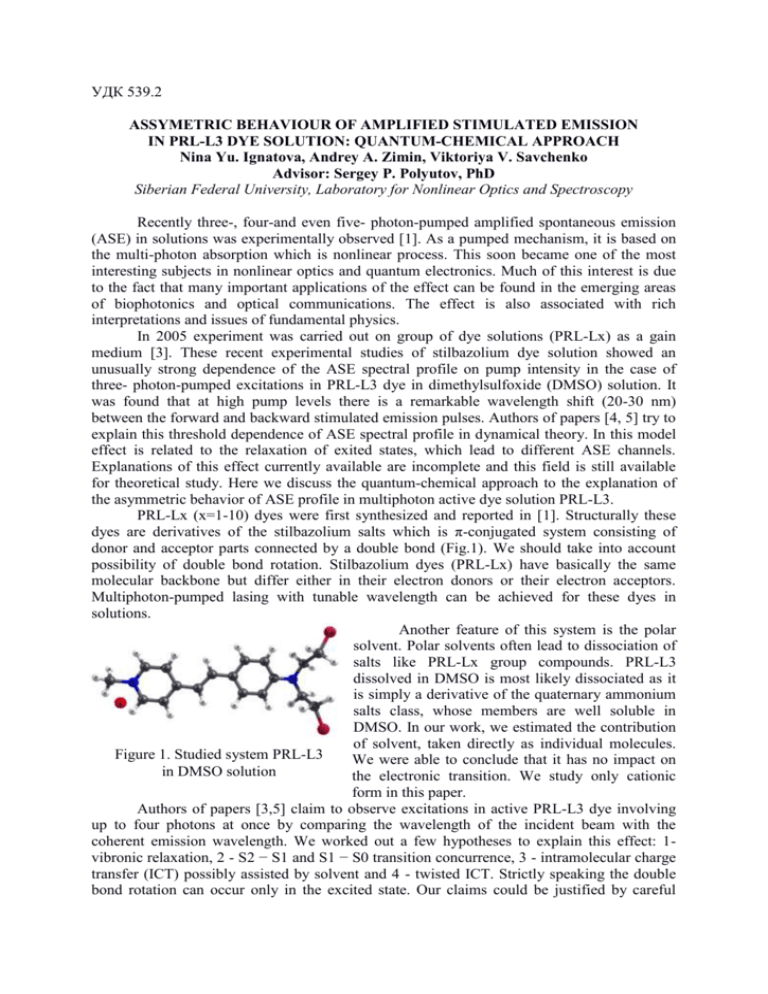
УДК 539.2 ASSYMETRIС BEHAVIOUR OF AMPLIFIED STIMULATED EMISSION IN PRL-L3 DYE SOLUTION: QUANTUM-CHEMICAL APPROACH Nina Yu. Ignatova, Andrey A. Zimin, Viktoriya V. Savchenko Advisor: Sergey P. Polyutov, PhD Siberian Federal University, Laboratory for Nonlinear Optics and Spectroscopy Recently three-, four-and even five- photon-pumped amplified spontaneous emission (ASE) in solutions was experimentally observed [1]. As a pumped mechanism, it is based on the multi-photon absorption which is nonlinear process. This soon became one of the most interesting subjects in nonlinear optics and quantum electronics. Much of this interest is due to the fact that many important applications of the effect can be found in the emerging areas of biophotonics and optical communications. The effect is also associated with rich interpretations and issues of fundamental physics. In 2005 experiment was carried out on group of dye solutions (PRL-Lx) as a gain medium [3]. These recent experimental studies of stilbazolium dye solution showed an unusually strong dependence of the ASE spectral profile on pump intensity in the case of three- photon-pumped excitations in PRL-L3 dye in dimethylsulfoxide (DMSO) solution. It was found that at high pump levels there is a remarkable wavelength shift (20-30 nm) between the forward and backward stimulated emission pulses. Authors of papers [4, 5] try to explain this threshold dependence of ASE spectral profile in dynamical theory. In this model effect is related to the relaxation of exited states, which lead to different ASE channels. Explanations of this effect currently available are incomplete and this field is still available for theoretical study. Here we discuss the quantum-chemical approach to the explanation of the asymmetric behavior of ASE profile in multiphoton active dye solution PRL-L3. PRL-Lx (x=1-10) dyes were first synthesized and reported in [1]. Structurally these dyes are derivatives of the stilbazolium salts which is π-conjugated system consisting of donor and acceptor parts connected by a double bond (Fig.1). We should take into account possibility of double bond rotation. Stilbazolium dyes (PRL-Lx) have basically the same molecular backbone but differ either in their electron donors or their electron acceptors. Multiphoton-pumped lasing with tunable wavelength can be achieved for these dyes in solutions. Another feature of this system is the polar solvent. Polar solvents often lead to dissociation of salts like PRL-Lx group compounds. PRL-L3 dissolved in DMSO is most likely dissociated as it is simply a derivative of the quaternary ammonium salts class, whose members are well soluble in DMSO. In our work, we estimated the contribution of solvent, taken directly as individual molecules. Figure 1. Studied system PRL-L3 We were able to conclude that it has no impact on in DMSO solution the electronic transition. We study only cationic form in this paper. Authors of papers [3,5] claim to observe excitations in active PRL-L3 dye involving up to four photons at once by comparing the wavelength of the incident beam with the coherent emission wavelength. We worked out a few hypotheses to explain this effect: 1vibronic relaxation, 2 - S2 − S1 and S1 − S0 transition concurrence, 3 - intramolecular charge transfer (ICT) possibly assisted by solvent and 4 - twisted ICT. Strictly speaking the double bond rotation can occur only in the excited state. Our claims could be justified by careful calculations of the ground state and several singlet excited states (S1, S2, ...), which to our knowledge haven’t yet been performed for the PRL-L3 dye. Ground-state S0 has been studied using computations at the DFT level, while excited S1 state was treated at the TD-DFT level. In all DFT and TD-DFT calculations we have used the CAM-B3LYP hybrid range-separated exchange-correlation functional and the same integration grid size. Geometry optimization for S0 and S1 states was done in two steps: 1 initial hessian estimation using small STO-6G basis with s,p diffuse augmentation and 2 further geometry optimization using aug-cc-pVDZ basis set. Vertical transition energies and dipole moments for S0 → Sn series were initially calculated using TD-DFT/aug-cc-pVDZ with M11 range-separated meta-GGA exchange-correlation functional. All these computations have been performed using the GAMESS package. We studied the process of photoisomerisation of PRL-L3 starting from the equilibrium geometry search of trans-isomer. Calculated energies and transition dipole moments of vertical transitions from the ground state S0 to the excited states S1–S10 at the TD-DFT for trans-PRL-L3 shown at the fig.2. It can be seen, that “S0 → S1” dominates the others with magnitude of dipole moment is 11.83D that 10 times bigger than others. We consider that higher exited states have no impact from the standpoint of interpreting on ASE profile. The experimental linear absorption spectra of the 0.2 μM PRL-L3/DMSO solution has one intense peak at 425 nm [5] corresponding to 2.743 eV transition. Magnitude of “S0 → S1” energy gap from our calculation corresponds well with peak position in the linear absorption spectra and the 3PP energy. Figure 2. a) Energy level scheme and transition dipole moments for the PRL-L3 cation; b) Potential energy scan of s0, s1 states across isomerization reaction pathway of PRL-L3 Then we have done potential energy scan of S0, S1 states across the double bond rotation coordinate of isomerization pathway of PRL-L3. Potential energy curves for S0, S1 states are asymmetric across the reaction coordinate (figure 2b). This result makes it possible to explain ASE. We assume that two formed isomers give ASE with different frequencies. Another important issue is the activation energy barrier of the isomerization process. Activation barrier in S1 excited state is about 0.5 eV and is much bigger then the thermal energy and photo-induced isomerization may occur here. We suppose isomerization may occur during the duration of pulse due to Rabi oscillations of coherence and population. The results of our research are possibly interesting both for the purpose of explaining ASE and by themselves, because detailed quantum chemical calculations PRL-L3 have not yet been performed. 1. 2. 3. 4. 5. G. S. He et. al., Opt. Lett. 20, 2393 (1995). Guang S. He et. al., J. Opt. Soc. Am. B Vol. 22, No. 10, 2219 (2005). Qingdong Zheng et.al. Nature Photonics 7, 234–239 (2013). Victor Kimberg et. al., Physical Review A 74, 033814 (2006). Guang S. He et. al., Physical Review A 73, 033815 (2006).


